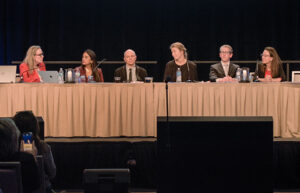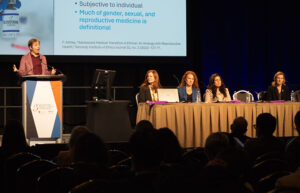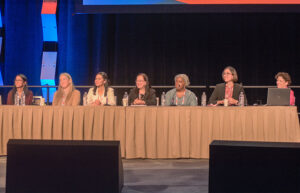Through the sequencing of breast tissue cells from both healthy individuals and those with various stages of breast cancer, researchers at the University of Cambridge have drawn a map of how the breast changes during tumorigenesis and progression to better understand different patient trajectories.
“The cellular composition of the healthy breast is quite dynamic,” said Walid Khaled, PhD, during the second Plenary Lecture at the 2024 San Antonio Breast Cancer Symposium®, adding that even healthy breast tissue includes subpopulations of cells with aberrant copy number variations.
Dr. Khaled is Professor of Tumor Initiation and Co-Leader of the Human Breast Cell Atlas initiative at the University of Cambridge. A recording of his presentation, Cell Atlases as Roadmaps in Cancer Immunology, held Friday, December 13, is available on demand for registered 2024 SABCS® participants through March 31, 2025.
While epithelial cell changes differ depending on the tumor’s mutational status and stage of development, there is some commonality in changes to immune cells, including an enrichment in immune cells, particularly CD4+ and CD8+ T cells, in pre-cancerous tissue, Dr. Khaled noted.
“We could definitely see these immune infiltrates happening in the BRCA1 and BRCA2 breast cancers. We could actually quantify it,” he said. “But what was really interesting and surprising at this point is there seems to be this immune resources phenotype.”
Compared to average-risk individuals, more PD1-positive T cells are found within BRCA1/2-mutated cancers. Several markers of immune exhaustion were seen in apparently normal tissues before the development of any tumors, Dr. Khaled explained.
“Other immune checkpoints are also upregulated,” he said. “We see an application of the ligands in the epithelial compartments, so the ER-negative luminal progenitor cells have high levels of PDL1, so other hormone sensing and even macrophages as well, suggesting that the entire microenvironment is effectively conditioning the tissue toward this tumor initiation.”
Work to build the Human Breast Cell Atlas began in 2019 with the goal of furthering the understanding of the early, pre-cancerous changes that occur in breast tissue to develop preventative therapies for breast cancer.
“The old saying goes, ‘Prevention is better than cure,’ but it’s been quite challenging, of course, to do this,” Dr. Khaled said. “But I think that bill payers and policymakers are really forcing us all to think more about this.”
Dr. Khaled’s focus is on the identification of abnormal tissue changes, including asymptomatic changes, that could lead to tumor initiation. Samples used in the atlas came from the Breast Cancer Now tissue bank and included more than 80 data points, such as body mass index (BMI) and age. Cells were categorized into three compartments for each sample: stromal cells, epithelial cells, and immune cells.
“We should all be thinking about the tissue state rather than a single biomarker or a handful of biomarkers,” Dr. Khaled said. “How does entire tissue actually respond? This is really quite important.”
Going forward, he also recommends looking for biomarkers of waning resilience in breast tissue.
“Since we’re all walking around with mutations, there must be some hardwired, resilience mechanisms within tissues, not just immune cells,” Dr. Khaled said.
Ongoing trials are exploring whether a tissue state response to having a mutation such as BRCA1 in mouse models can prevent pre-cancerous changes. Researchers also are developing ways to noninvasively measure early, pre-cancerous tissue changes.
But the success of any therapeutics for breast cancer prevention must be measured through more timely methods than are currently being used, Dr. Khaled said.
“No one wants to wait for 10, 15 years to see if tumors will develop, so we need to think of different ways of doing it,” he said. “We also need to develop different types of drugs. We can’t be developing the traditional oncology approach of drugs that kill cells.”
Data from the Human Breast Cell Atlas is available through CellxGene. The data also have been added to an integrated human breast cell atlas as part of the Human Cell Atlas.
Join us at SABCS 2025
Connect with thousands of basic and translational scientists, multidisciplinary clinicians, regulatory and pharmaceutical partners, survivors, and patient advocates at the 48th annual San Antonio Breast Cancer Symposium®. Complete your registration by Friday, September 26, to take advantage of discounted early registration rates.





